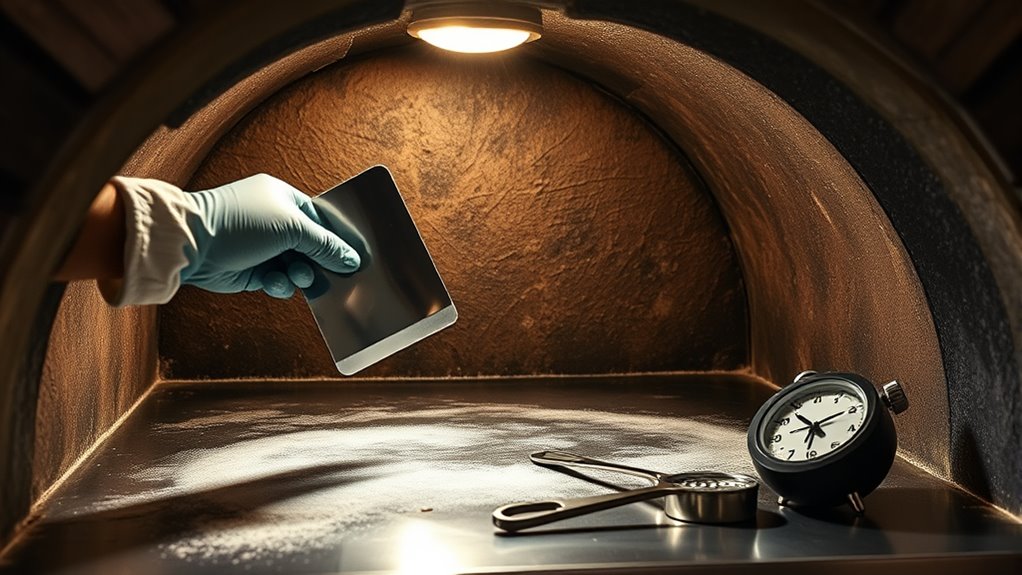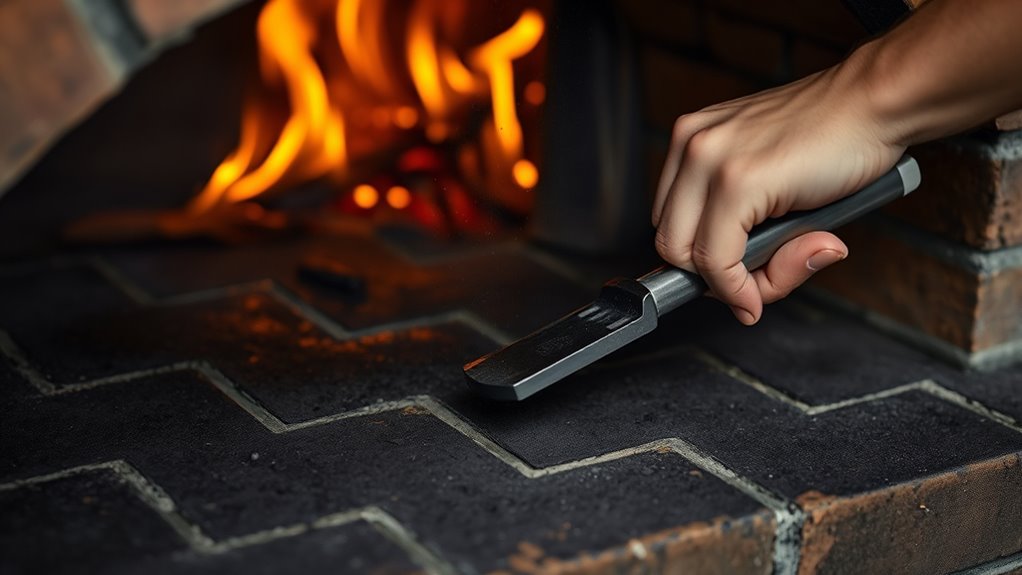To quickly desoot your wood oven in 15 minutes, start by wearing gloves, goggles, and a dust mask for safety. Use a stiff wire brush and scraper to loosen thick soot on the walls and grate, then vacuum the debris with a specialized ash vac. Wipe the interior with a damp cloth to remove remaining residue, paying special attention to the flue area with a chimney brush if needed. Keep following these steps to master fast, safe cleanup.
Key Takeaways
- Wear protective gear and ensure proper ventilation before starting the cleaning process.
- Use stiff wire brushes and scrapers to quickly loosen thick soot buildup.
- Employ a ash vacuum to efficiently remove loose debris and soot residues.
- Wipe interior surfaces with damp cloths to catch remaining dust and prevent airborne particles.
- Focus on chimney and flue areas with a chimney brush for a thorough yet swift desooting.
Quick and Easy Soot Removal Tips

If your wood oven has become increasingly smoky or inefficient, tackling the soot buildup quickly can restore its performance. Soot accumulation not only hampers heat output but also poses safety risks, so addressing it promptly is vital. Before you begin, prioritize safety precautions. Wear gloves, safety goggles, and a dust mask to protect yourself from ash and soot particles, which can become airborne during cleaning. Make sure the area around your oven is well-ventilated to avoid inhaling dust or fumes.
Gather your cleaning tools before starting—stiff wire brushes, scrapers, a vacuum designed for ash removal, and a damp cloth or sponge for wiping down surfaces. These tools are essential for a thorough clean and will make the process faster and more effective. Start by inspecting the interior of your oven and identify the thickest layers of soot. Use your wire brush or scraper to gently loosen and dislodge the buildup from the oven walls and grate. Be careful not to damage any heat-sensitive components. Once you’ve loosened the soot, use a vacuum with a hose attachment to carefully suck up the debris, ensuring you remove all loose particles. This prevents the soot from settling deeper into crevices and keeps the oven cleaner longer.
After removing the loose soot, wipe down the interior with a damp cloth or sponge to pick up any remaining ash or residue. If you notice stubborn spots, apply a bit of mild soap or specialized oven cleaner, but avoid harsh chemicals that could damage the oven or leave residues. Pay special attention to the chimney or flue area, as soot often accumulates there and can restrict airflow. Use a chimney brush if needed, but make sure you’re following safety precautions to prevent soot from falling into your workspace or causing a fire hazard. Regular cleaning also helps maintain the efficiency of your wood oven, ensuring optimal heat output and safety.
Once you’ve cleaned the interior thoroughly, double-check that all tools are cleared away and that the oven is dry before use. Regular maintenance, like cleaning after each use or weekly checks, will prevent heavy soot buildup and keep your oven running efficiently. Remember, quick cleanups don’t have to be complicated—using the right cleaning tools and following safety precautions guarantees a swift, safe, and effective desooting process. With just 15 minutes, your wood oven can be restored to peak performance, saving you time and effort in the long run.
Frequently Asked Questions
Can Desooting Damage the Oven’s Interior Finish?
Desooting your oven generally won’t damage the interior finish if you do it carefully. You should avoid harsh scrubbing or using abrasive materials that could scratch the oven surface or damage the interior finish. Instead, gently remove ash and debris, and clean the surface with a soft cloth. Proper maintenance helps preserve the oven’s appearance and ensures it functions efficiently without risking harm to the interior finish.
Is Special Equipment Needed for Quick Soot Removal?
You don’t need specialized tools or cleaning agents for quick soot removal. Instead, use a simple wire brush or a scraper to loosen the soot, and a damp cloth to wipe away residue. These basic tools are effective and safe for your oven’s interior finish. Carefully follow the cleaning process to avoid damaging any surfaces, and verify the oven is cool before starting.
How Often Should I Desoot My Wood Oven?
You should decontaminate your wood oven after every 1-2 cords of wood burned or at least once a month during heavy use. Regular oven maintenance through consistent cleaning frequency prevents buildup and ensures efficient operation. Keep an eye on the amount of soot and creosote, and don’t wait too long between cleanings. This way, you maintain safety, improve heat retention, and keep your oven running smoothly.
Are Chemical Cleaners Safe for Oven Surfaces?
You might wonder if chemical cleaners are safe for your oven surfaces. The truth is, many chemicals can threaten surface integrity and pose safety risks. Always check labels for chemical safety and opt for non-toxic, oven-safe products. Using the wrong cleaners could damage your oven or leave harmful residues. To keep your oven pristine and safe, choose gentle, proven cleaning methods that protect both your oven’s surface and your health.
Can I Desoot a Wood Oven Without Professional Help?
Yes, you can desoot your wood oven without professional help by following DIY tips. Start by safely removing ashes and debris after each use, then perform a thorough cleaning using a brush and mild cleaning solutions. Incorporate desooting into your maintenance schedule to keep your oven functioning efficiently. Regular maintenance prevents buildup, making desooting easier and quicker, and guarantees your oven stays safe and ready for cooking.
Conclusion
By following these quick wins, you’ll keep your wood oven clean, maintain its efficiency, and enjoy better cooking results. You’ll save time, prevent buildup, and extend its lifespan—all in just 15 minutes. With simple steps, consistent effort, and a little bit of routine, you’ll master desooting with ease. So, stay diligent, stay prepared, and keep your wood oven in top shape—quickly, easily, and confidently.









